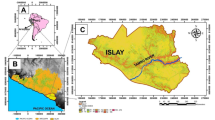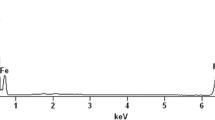Abstract
Magnetites (MEBWx) were prepared by precipitation in 1-butanol/water mixtures of various mole ratios of 1-butanol to water. It was found that the magnetites prepared in the mixture with high mole ratio of 1-butanol to water have high specific surface area. The adsorption isotherms of As(III) and As(V) with the magnetites at 303 K fitted the Langmuir model well. The adsorption capacities of the magnetite prepared in the mixtures were higher than those of the magnetite prepared without 1-butanol. Their adsorption capacities increased with increasing specific surface area.


Similar content being viewed by others
References
Dixit, S., & Hering, J. G. (2003). Comparison of arsenic (V) and arsenic (III) sorption onto iron oxide minerals: Implications for arsenic mobility. Environmental Science and Technology, 37, 4182–4189.
Gimenez, J., Martinez, M., de Pablo, L., Rovira, M., & Duro, L. (2007). Arsenic sorption on to natural hematite, magnetite, and goethite. Journal of Hazardous Materials, 141, 575–580.
Mayo, J. T., Yavuz, C., Yean, S., Cong, L., Shipley, H., Yu, W., et al. (2007). The effect of nanocrystalline magnetite size on arsenic removal. Science and Technology of Advanced Materials, 8, 71–75.
Ohe, K., Tagai, Y., Nakamura, S., Oshima, T., & Baba, Y. (2005). Adsorptive behavior of arsenic (III) and Arsenic (V) using magnetite. Journal of Chemical Engineering of Japan, 38, 671–676.
Parga, J. R., Cockeb D. L., Valenzuelac J. L., Gomesb J. A., Kesmezb M., Irwind G., Morenob H., & Weirb M. (2005). Arsenic removal via electrocoagulation from heavy metal contaminated groundwater in La Comarca Lagunera Mexico. Journal of Hazardous Materials, 124, 247–254.
Parsons, G. J., Lpoez, L. M., Peralta-Videa, R. J., & Gardea-Torresdey, L. J. (2009). Determination of arsenic (III) and arsenic (V) binding to microwave assisted hydrothermal synthetically prepared Fe3O4, Mn3O4, and MnFe2O4 nanoadsorbents. Microchemical Journal, 91, 100–106.
Roychowdhury, T., Tokunaga, H., Uchino, T., & Ando, M. (2005). Effect of arsenic-contaminated irrigation water on agricultural land soil and plants in West Bengal, India. Chemosphere, 58, 799–810.
Tanabe, K., Yokota, H., Hironaka, H., Tsushima, S., & Kubota, Y. (2001). Arsenic pollution of groundwater in Bangladesh. Applied Organometallic Chemistry, 15, 241–251.
Wang, J., Wu, Y., & Zhu, Y. (2007). Fabrication of complex of Fe3O4 nanorods by magnetic-field-assisted solvothermal process. Materials Chemistry and Physics, 106, 1–4.
Acknowledgments
This work was supported by Grant-in-Aid for Scientific Research (C) (20510078) of Japan Society for the Promotion of Science.
Author information
Authors and Affiliations
Corresponding author
Rights and permissions
About this article
Cite this article
Ohe, K., Oshima, T. & Baba, Y. Adsorption of arsenic using high surface area magnetites. Environ Geochem Health 32, 283–286 (2010). https://doi.org/10.1007/s10653-010-9298-6
Received:
Accepted:
Published:
Issue Date:
DOI: https://doi.org/10.1007/s10653-010-9298-6




